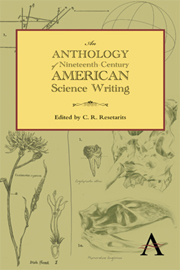Book contents
- Frontmatter
- Contents
- Preface
- Part One 1800–1846 Naturals and Naturalists
- Part One Introduction
- “A Memoir on the Discovery of Certain Bones of a Quadruped of the Clawed Kind in the Western Parts of Virginia,” Transactions of the American Philosophical Society (1799)
- “Pileated Woodpecker,” American Ornithology; or the Natural History of the Birds of the United States (1801)
- “Currents,” The New American Practical Navigator (1802)
- “Account of a North American Quadruped, supposed to belong to the Genus Ovis, Rocky-Mountain Sheep, Ovis Montana,” Journal of the Academy of Natural Sciences of Philadelphia (1817)
- “A Monograph of North American insects, of the genus Cincindela” (excerpt) Transactions of the American Philosophical Society (1818)
- “On the Genus Ocythoe,” Philosophical Transactions of the Royal Society of London (1819)
- “Preface,” American Entomology, or Descriptions of the Insects of North America (1824–28)
- “Preface” (excerpt), The Genera of North American Plants and a Catalogue of the Species, to the Year 1817 (1818)
- “Pileated Woodpecker,” Manual of the Ornithology of the United States and Canada (1832)
- “Introduction,” Ichthyologia ohiensis, or natural history of the fishes inhabiting the river Ohio and its tributary streams (1820)
- “Notices of Materia Medica, or new medical properties of some American Plants,” Western Minerva or, American Annals of Knowledge and Literature (1820)
- “Passenger Pigeon,” Ornithological Biography (1831)
- “On the Production of Currents and Sparks of Electricity from Magnetism,” American Journal of Science and Arts (July 1832)
- “The Contagiousness of Puerperal Fever” (excerpts), New England Quarterly Journal of Medicine (1843)
- “On the Two Storms Which Were Experienced throughout the United States, in the Month of February, 1842” (excerpt) Transactions of the American Philosophical Society (1845)
- Part Two 1846–1876 Warriors
- Part Three 1876–1900 Scientists
- Bibliography
“On the Production of Currents and Sparks of Electricity from Magnetism,” American Journal of Science and Arts (July 1832)
from Part One - 1800–1846 Naturals and Naturalists
Published online by Cambridge University Press: 05 June 2012
- Frontmatter
- Contents
- Preface
- Part One 1800–1846 Naturals and Naturalists
- Part One Introduction
- “A Memoir on the Discovery of Certain Bones of a Quadruped of the Clawed Kind in the Western Parts of Virginia,” Transactions of the American Philosophical Society (1799)
- “Pileated Woodpecker,” American Ornithology; or the Natural History of the Birds of the United States (1801)
- “Currents,” The New American Practical Navigator (1802)
- “Account of a North American Quadruped, supposed to belong to the Genus Ovis, Rocky-Mountain Sheep, Ovis Montana,” Journal of the Academy of Natural Sciences of Philadelphia (1817)
- “A Monograph of North American insects, of the genus Cincindela” (excerpt) Transactions of the American Philosophical Society (1818)
- “On the Genus Ocythoe,” Philosophical Transactions of the Royal Society of London (1819)
- “Preface,” American Entomology, or Descriptions of the Insects of North America (1824–28)
- “Preface” (excerpt), The Genera of North American Plants and a Catalogue of the Species, to the Year 1817 (1818)
- “Pileated Woodpecker,” Manual of the Ornithology of the United States and Canada (1832)
- “Introduction,” Ichthyologia ohiensis, or natural history of the fishes inhabiting the river Ohio and its tributary streams (1820)
- “Notices of Materia Medica, or new medical properties of some American Plants,” Western Minerva or, American Annals of Knowledge and Literature (1820)
- “Passenger Pigeon,” Ornithological Biography (1831)
- “On the Production of Currents and Sparks of Electricity from Magnetism,” American Journal of Science and Arts (July 1832)
- “The Contagiousness of Puerperal Fever” (excerpts), New England Quarterly Journal of Medicine (1843)
- “On the Two Storms Which Were Experienced throughout the United States, in the Month of February, 1842” (excerpt) Transactions of the American Philosophical Society (1845)
- Part Two 1846–1876 Warriors
- Part Three 1876–1900 Scientists
- Bibliography
Summary
Although the discoveries of Oersted, Arago, Faraday, and others, have placed the intimate connection of electricity and magnetism in a most striking point of view, and although the theory of Ampere has referred all the phenomena of both these departments of science to the same general laws, yet until lately one thing remained to be proved by experiment, in order more fully to establish their identity; namely, the possibility of producing electrical effects from magnetism. It is well known that surprising magnetic results can readily be obtained from electricity, and at first sight it might be supposed that electrical effects could with equal facility be produced from magnetism; but such has not been found to be the case, for although the experiment has often been attempted it has nearly as often failed.
It early occurred to me, that if galvanic magnets, on my plan, were substituted for ordinary magnets, in researches of this kind, more success might be expected. Besides their great power, these magnets possess other properties, which render them important instruments in the hands of the experimenter; their polarity can be instantaneously reversed, and their magnetism suddenly destroyed or called into full action, according as the occasion may require. With this view, I commenced, last August, the construction of a much larger galvanic magnet than, to my knowledge, had before been attempted, and also made preparations for a series of experiments with it on a large scale, in reference to the production of electricity from magnetism.
- Type
- Chapter
- Information
- Publisher: Anthem PressPrint publication year: 2012



